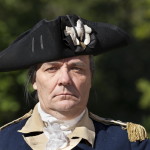
May 15, 1776. As debate wound down and the time to vote approached, a crowd gathered in the streets of Williamsburg.
Inside the Capitol, one by one, delegates to the Fifth Virginia Convention voted for independence.
The vote was unanimous.
And even before the polling was complete, preparation had begun to lower the Union Jack flying overhead.
In its place the people raised the Grand Union flag, which featured the British colors in the upper left-hand corner and 13 alternating red and white stripes representing the American colonies.
Virginia was the first to make the break from Great Britain official and asked the Second Continental Congress meeting in Philadelphia to likewise “declare the United Colonies free and independent States, absolved from all allegiance to, or dependence upon, the Crown or Parliament of Great Britain.”
“The exultation here was extreme,” wrote delegate Thomas Ludwell Lee to his younger brother about the happenings in Williamsburg. His brother was Richard Henry Lee, who would introduce Virginia’s resolution for independence at the Continental Congress on June 7.
The celebration continued through the next day with a public reading of the resolutions, Gen. Lewis’s review of the troops at Waller’s Grove and various “demonstrations of joy,” including parades, toasts and the firing of cannon.
May 17 was a day of fasting and prayer, and Rev. Mr. Thomas Price delivered a sermon to a packed house at Bruton Parish Church.
For a year, the Grand Union flag, which first appeared in late 1775 and was soon used by the Continental Army under George Washington, was the new nation’s standard. In June 1777, the Continental Congress adopted the stars and stripes.
But it was the Grand Union flag that flew as the United States took its first tentative steps as an independent nation. It was a suitable symbol for a people making the transition from British subjects to American citizens.
And that is why it appears again throughout Colonial Williamsburg’s Historic Area to indicate open buildings. In Williamsburg, the debates of 1776 live on, and all are invited to join the American conversation.



Leave a Reply